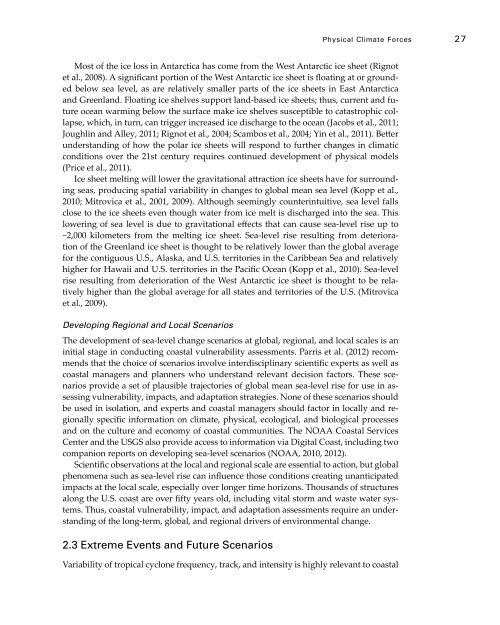Coastal Impacts, Adaptation, and Vulnerabilities - Climate ...
Coastal Impacts, Adaptation, and Vulnerabilities - Climate ...
Coastal Impacts, Adaptation, and Vulnerabilities - Climate ...
You also want an ePaper? Increase the reach of your titles
YUMPU automatically turns print PDFs into web optimized ePapers that Google loves.
Physical <strong>Climate</strong> Forces 27Most of the ice loss in Antarctica has come from the West Antarctic ice sheet (Rignotet al., 2008). A significant portion of the West Antarctic ice sheet is floating at or groundedbelow sea level, as are relatively smaller parts of the ice sheets in East Antarctica<strong>and</strong> Greenl<strong>and</strong>. Floating ice shelves support l<strong>and</strong>-based ice sheets; thus, current <strong>and</strong> futureocean warming below the surface make ice shelves susceptible to catastrophic collapse,which, in turn, can trigger increased ice discharge to the ocean (Jacobs et al., 2011;Joughlin <strong>and</strong> Alley, 2011; Rignot et al., 2004; Scambos et al., 2004; Yin et al., 2011). Betterunderst<strong>and</strong>ing of how the polar ice sheets will respond to further changes in climaticconditions over the 21st century requires continued development of physical models(Price et al., 2011).Ice sheet melting will lower the gravitational attraction ice sheets have for surroundingseas, producing spatial variability in changes to global mean sea level (Kopp et al.,2010; Mitrovica et al., 2001, 2009). Although seemingly counterintuitive, sea level fallsclose to the ice sheets even though water from ice melt is discharged into the sea. Thislowering of sea level is due to gravitational effects that can cause sea-level rise up to~2,000 kilometers from the melting ice sheet. Sea-level rise resulting from deteriorationof the Greenl<strong>and</strong> ice sheet is thought to be relatively lower than the global averagefor the contiguous U.S., Alaska, <strong>and</strong> U.S. territories in the Caribbean Sea <strong>and</strong> relativelyhigher for Hawaii <strong>and</strong> U.S. territories in the Pacific Ocean (Kopp et al., 2010). Sea-levelrise resulting from deterioration of the West Antarctic ice sheet is thought to be relativelyhigher than the global average for all states <strong>and</strong> territories of the U.S. (Mitrovicaet al., 2009).Developing Regional <strong>and</strong> Local ScenariosThe development of sea-level change scenarios at global, regional, <strong>and</strong> local scales is aninitial stage in conducting coastal vulnerability assessments. Parris et al. (2012) recommendsthat the choice of scenarios involve interdisciplinary scientific experts as well ascoastal managers <strong>and</strong> planners who underst<strong>and</strong> relevant decision factors. These scenariosprovide a set of plausible trajectories of global mean sea-level rise for use in assessingvulnerability, impacts, <strong>and</strong> adaptation strategies. None of these scenarios shouldbe used in isolation, <strong>and</strong> experts <strong>and</strong> coastal managers should factor in locally <strong>and</strong> regionallyspecific information on climate, physical, ecological, <strong>and</strong> biological processes<strong>and</strong> on the culture <strong>and</strong> economy of coastal communities. The NOAA <strong>Coastal</strong> ServicesCenter <strong>and</strong> the USGS also provide access to information via Digital Coast, including twocompanion reports on developing sea-level scenarios (NOAA, 2010, 2012).Scientific observations at the local <strong>and</strong> regional scale are essential to action, but globalphenomena such as sea-level rise can influence those conditions creating unanticipatedimpacts at the local scale, especially over longer time horizons. Thous<strong>and</strong>s of structuresalong the U.S. coast are over fifty years old, including vital storm <strong>and</strong> waste water systems.Thus, coastal vulnerability, impact, <strong>and</strong> adaptation assessments require an underst<strong>and</strong>ingof the long-term, global, <strong>and</strong> regional drivers of environmental change.2.3 Extreme Events <strong>and</strong> Future ScenariosVariability of tropical cyclone frequency, track, <strong>and</strong> intensity is highly relevant to coastal
















